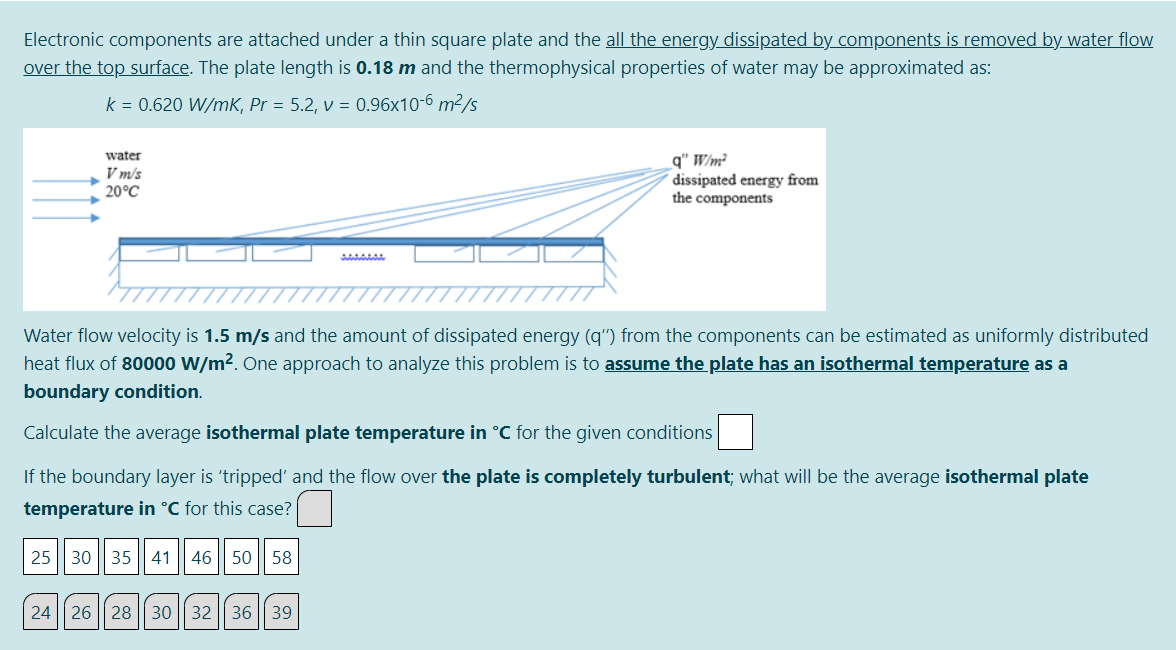Electronic components are attached under a thin square plate and the all the energy dissipated by components is removed by water flow over the top surface. The plate length is 0.18 m and the thermophysical properties of water may be approximated as: k = 0.620 W/mK, Pr = 5.2, v = 0.96x10-6 m²/s water V m/s 20°C q" W/m² dissipated energy from the components Water flow velocity is 1.5 m/s and the amount of dissipated energy (q") from the components can be estimated as uniformly distributed heat flux of 80000 W/m?. One approach to analyze this problem is to assume the plate has an isothermal temperature as a boundary condition. Calculate the average isothermal plate temperature in °C for the given conditions If the boundary layer is 'tripped' and the flow over the plate is completely turbulent; what will be the average isothermal plate temperature in °C for this case? 25 30 || 35| 41 46 || 50|| 58 24 26 || 28 30 || 32 36 || 39
Electronic components are attached under a thin square plate and the all the energy dissipated by components is removed by water flow over the top surface. The plate length is 0.18 m and the thermophysical properties of water may be approximated as: k = 0.620 W/mK, Pr = 5.2, v = 0.96x10-6 m²/s water V m/s 20°C q" W/m² dissipated energy from the components Water flow velocity is 1.5 m/s and the amount of dissipated energy (q") from the components can be estimated as uniformly distributed heat flux of 80000 W/m?. One approach to analyze this problem is to assume the plate has an isothermal temperature as a boundary condition. Calculate the average isothermal plate temperature in °C for the given conditions If the boundary layer is 'tripped' and the flow over the plate is completely turbulent; what will be the average isothermal plate temperature in °C for this case? 25 30 || 35| 41 46 || 50|| 58 24 26 || 28 30 || 32 36 || 39
Principles of Heat Transfer (Activate Learning with these NEW titles from Engineering!)
8th Edition
ISBN:9781305387102
Author:Kreith, Frank; Manglik, Raj M.
Publisher:Kreith, Frank; Manglik, Raj M.
Chapter5: Analysis Of Convection Heat Transfer
Section: Chapter Questions
Problem 5.57P
Related questions
Question
heat transfer
question is image

Transcribed Image Text:Electronic components are attached under a thin square plate and the all the energy dissipated by components is removed by water flow
over the top surface. The plate length is 0.18 m and the thermophysical properties of water may be approximated as:
k = 0.620 W/mK, Pr = 5.2, v = 0.96x10-6 m²/s
water
V m/s
20°C
q" W/m²
dissipated energy from
the components
Water flow velocity is 1.5 m/s and the amount of dissipated energy (q") from the components can be estimated as uniformly distributed
heat flux of 80000 W/m?. One approach to analyze this problem is to assume the plate has an isothermal temperature as a
boundary condition.
Calculate the average isothermal plate temperature in °C for the given conditions
If the boundary layer is 'tripped' and the flow over the plate is completely turbulent; what will be the average isothermal plate
temperature in °C for this case?
25 30 || 35| 41
46 || 50|| 58
24 26 || 28
30 || 32
36 || 39
Expert Solution
This question has been solved!
Explore an expertly crafted, step-by-step solution for a thorough understanding of key concepts.
Step by step
Solved in 2 steps with 2 images

Knowledge Booster
Learn more about
Need a deep-dive on the concept behind this application? Look no further. Learn more about this topic, mechanical-engineering and related others by exploring similar questions and additional content below.Recommended textbooks for you

Principles of Heat Transfer (Activate Learning wi…
Mechanical Engineering
ISBN:
9781305387102
Author:
Kreith, Frank; Manglik, Raj M.
Publisher:
Cengage Learning

Principles of Heat Transfer (Activate Learning wi…
Mechanical Engineering
ISBN:
9781305387102
Author:
Kreith, Frank; Manglik, Raj M.
Publisher:
Cengage Learning